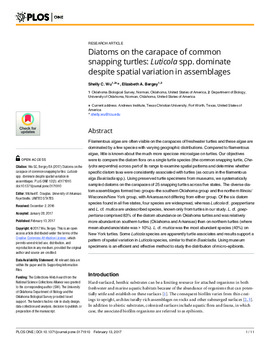| dc.creator | Wu, Shelly C. | |
| dc.creator | Bergey, Elizabeth A. | |
| dc.date.accessioned | 2017-03-07T17:39:01Z | |
| dc.date.available | 2017-03-07T17:39:01Z | |
| dc.date.issued | 2017-02-13 | |
| dc.identifier.citation | Wu SC, Bergey EA (2017) Diatoms on the carapace of common snapping turtles: Luticola spp. dominate despite spatial variation in assemblages. PLoS ONE 12(2): e0171910. doi:10.1371/journal.pone.0171910 | en_US |
| dc.identifier.uri | https://hdl.handle.net/11244/49354 | |
| dc.description.abstract | Filamentous algae are often visible on the carapaces of freshwater turtles and these algae are dominated by a few species with varying geographic distributions. Compared to filamentous algae, little is known about the much more speciose microalgae on turtles. Our objectives were to compare the diatom flora on a single turtle species (the common snapping turtle, Chelydra serpentina) across part of its range to examine spatial patterns and determine whether specific diatom taxa were consistently associated with turtles (as occurs in the filamentous alga Basicladia spp.). Using preserved turtle specimens from museums, we systematically sampled diatoms on the carapaces of 25 snapping turtles across five states. The diverse diatom assemblages formed two groups–the southern Oklahoma group and the northern Illinois/Wisconsin/New York group, with Arkansas not differing from either group. Of the six diatom species found in all five states, four species are widespread, whereas Luticola cf. goeppertiana and L. cf. mutica are undescribed species, known only from turtles in our study. L. cf. goeppertiana comprised 83% of the diatom abundance on Oklahoma turtles and was relatively more abundant on southern turtles (Oklahoma and Arkansas) than on northern turtles (where mean abundance/state was > 10%). L. cf. mutica was the most abundant species (40%) on New York turtles. Some Luticola species are apparently turtle associates and results support a pattern of spatial variation in Luticola species, similar to that in Basicladia. Using museum specimens is an efficient and effective method to study the distribution of micro-epibionts. | en_US |
| dc.description.sponsorship | The Collections-Web Award from the National Science Collections Alliance was granted to the corresponding author (SW). The University of Oklahoma Department of Biology and the Oklahoma Biological Survey provided travel support. The funders had no role in study design, data collection and analysis, decision to publish, or preparation of the manuscript. | en_US |
| dc.format.extent | 11 pages | |
| dc.format.extent | 954,599 bytes | |
| dc.format.medium | application.pdf | |
| dc.language | en_US | en_US |
| dc.relation.requires | Adobe Acrobat Reader | |
| dc.rights | Attribution 3.0 United States | * |
| dc.rights.uri | https://creativecommons.org/licenses/by/3.0/us/ | * |
| dc.subject.lcsh | Epibiosis | |
| dc.subject.lcsh | Chelydra serpentina -- Microbiology -- United States | |
| dc.subject.lcsh | Diatoms -- Ecology -- United States | |
| dc.title | Diatoms on the carapace of common snapping turtles : Luticola spp. dominate despite spatial variation in assemblages | en_US |
| dc.type | Article | en_US |
| dc.type | text | |
| dc.description.peerreview | Yes | en_US |
| dc.identifier.doi | doi.org/10.1371/journal.pone.0171910 | en_US |
| ou.group | College of Arts and Sciences::Department of Biology | en_US |

